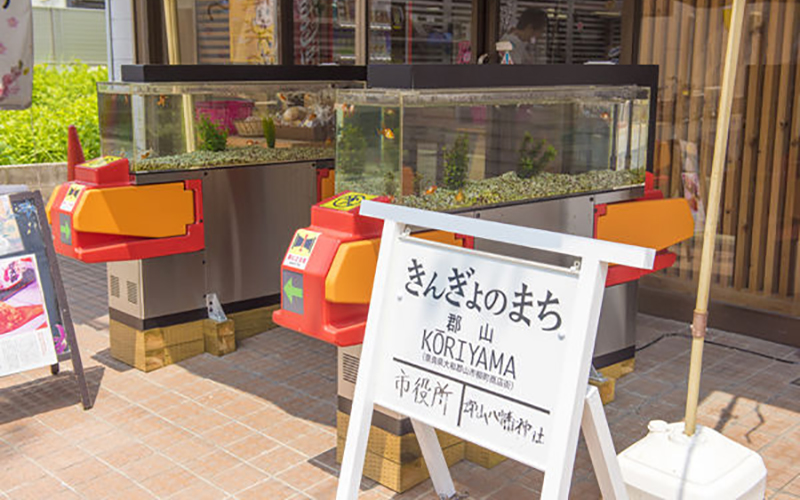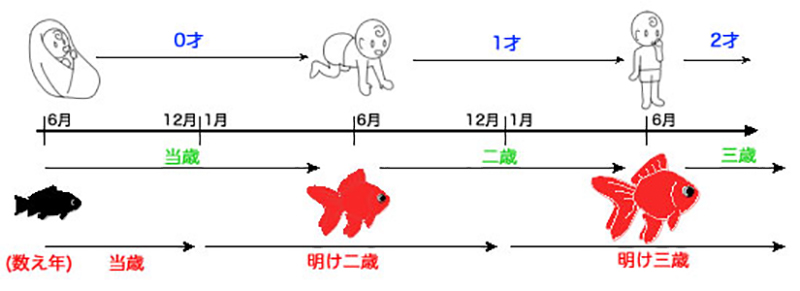knowledge
When purchasing a goldfish, the selection criteria may vary from person to person. In addition, the information provided by the store may also give you some hints on how to choose the right one. In this article, we would like to explain the points to choose the right goldfish among many goldfish.
Table of Contents

Although I will explain this as an advanced section, it is a point that I would like you to see when you purchase the product, and I would like you to know it even if you are a beginner.
When you look at the sales section of goldfish at a specialty store or on the Internet, you may see the name of the production area, such as "produced in XX". For those who are new to goldfish, it is better to consider the type of goldfish you like and their compatibility with other goldfish rather than the place of origin, but even the same species will have different characteristics depending on the place of origin. The characteristics of goldfish vary from region to region, and it is even better to prepare the breeding environment according to these differences. The first point to look at is whether the fish is domestic or foreign (imported).Domestic goldfish have their own characteristics, as explained in the following article, but there is little need to pay attention to the environment in which they are kept. However, goldfish produced overseas are a little different. Most of them are from China and Southeast Asia. Both of these regions are cultivated in warm regions. Therefore, they are not accustomed to Japanese winters in most cases. Therefore, when keeping goldfish from overseas, many people use heaters to keep the temperature above 20°C (68°F). Many foreign (especially Chinese) goldfish have varieties and characteristics not found in domestic goldfish, and are recommended for those who want a rare or maniacal goldfish. If you are concerned, it is better to ask what temperature the aquarium containing the goldfish was kept at in the store or other places before purchasing. Domestic goldfish can basically be kept without a heater in many cases, so if you do not want to add a heater, domestic goldfish are often a better choice.

The item written with the place of origin above is age.You may have often seen goldfish with their age written on them, such as "two years old" or "dawn two years old," but not many people choose goldfish based on their age. Even if you know the age of a goldfish, there is no way to choose it if you do not know what it means.
First, let me explain the age of goldfish. Words that are often written in the age section include: "Touzai," "Nisai," "Dake Nisai," "Sansai," "Dake Sansai," and so on. The "Dawn XX" will be explained later.The other notation of age that I have not seen is "tōzai" (当歳). Generally speaking, this term is not very familiar to us. Tōzai" simply means "zero years old. In other words, it refers to a goldfish that has not yet been born for a year.The current yearling is a goldfish that usually begins to be distributed after October. The characteristics of this age group are that they are inexpensive and have a good future. However, the probability of death is also very high. The "mizusai" is a risky goldfish because it is still a baby and has a very high risk of death, although it has a good future. It is the most unsuitable goldfish for beginners, so please be careful. The "two years old" and "three years old" goldfish are those that are two or three years old.
One more thing,It may be written as "Dawn XX," such as "Dawn Nisai." The difference between a normal two-year-old and a dawn two-year-old is the standard. Nisai means two years old from the day of birth. Generally, it means around April or May. Dawn nisai refers to the year from the year of birth, not the day of birth. In other words, a goldfish born in the year from January to December is described as two years old at the beginning of the next year. The term is used in the sense of "two years old by count."
The wording is rather cumbersome, so I think it will be easier to understand if you watch the image above. Recently, the concept of counting years is becoming less common, and more and more stores and websites are only using "two years old" or "three years old" as the age of goldfish.
The first step in selecting goldfish according to age is to consider the purpose for which the goldfish will be kept by the person keeping them. For example, "I want a goldfish that is easy to keep," or "I want a goldfish to be used as a parent because I want it to spawn," etc. The reasons for this vary. There are goldfish of various ages, but the price tends to increase as the age of the goldfish increases.
As explained in the above section, the "Tosei" are difficult to keep, but they are recommended for those who want to keep a large number of goldfish in the future. On the other hand, it is not recommended for beginners.
Many of the goldfish are relatively easy to keep and reasonably priced for one and two year olds. This is especially recommended for beginners and those who are looking for an easy-to-keep goldfish. This age is the part where there is the greatest variety and opportunity to see them because they are the most widely distributed.
At three years of age, they are easier to keep, but are often more expensive and have larger bodies. Normally, it is said that the best goldfish to use as parents are three years old, so if you want a goldfish for spawning, three-year-old goldfish are recommended. It is also recommended for those who want large individuals. If you have an idea of what kind of goldfish you want, please take a look at the age of the goldfish as a reference.